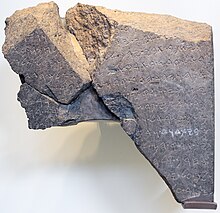Tel Dan Stele

Tel Dan Stele, Israel Museum
|
|
| Material | Basalt |
|---|---|
| Writing | Old Aramaic (Phoenician alphabet) |
| Created | 870–750 BCE |
| Discovered | 1993–94 |
| Present location | Israel Museum |
The Tel Dan Stele is a broken stele (inscribed stone) discovered in 1993–94 during excavations at Tel Dan in northern Israel. It consists of several fragments making up part of a triumphal inscription in Aramaic, left most probably by Hazael of Aram-Damascus, an important regional figure in the late 9th century BCE. Hazael (or more accurately, the unnamed king) boasts of his victories over Omri, the king of Israel and his ally the king of the "House of David" (bytdwd). It is considered the first widely accepted reference to the name David as the founder of a Judahite polity outside of the Hebrew Bible, though the earlier Mesha stele contains several possible references with varying acceptance. A minority of scholars have disputed the reference to David, due to the lack of a word divider between byt and dwd, and other translations have been proposed. The stele was not excavated in its primary context, but in its secondary use. The Tel Dan stele is one of four known contemporary inscriptions containing the name of Israel, the others being the Merneptah Stele, the Mesha Stele, and the Kurkh Monolith.
The Tel Dan inscription generated considerable debate and a flurry of articles, debating its age, authorship, and authenticity; however, the Stele is generally accepted by scholars as genuine and a reference to the House of David. It is currently on display in the Israel Museum in Jerusalem.
The stele was discovered by Avraham Biran at Tel Dan in the northern part of modern Israel (fragment A in July 1993 and fragments B1 and B2 in June 1994). The Stele was not excavated in its "primary context", but in its "secondary use".
...
Wikipedia
